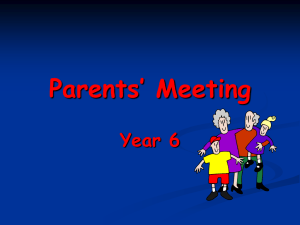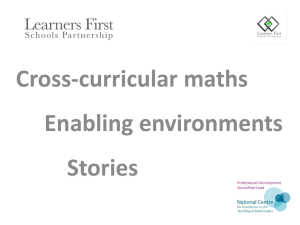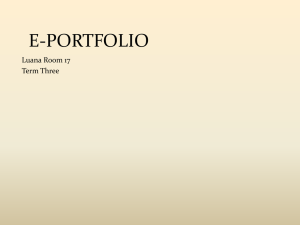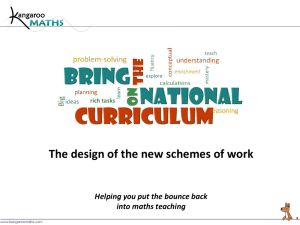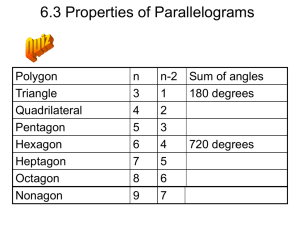Elm Hall Primary curriculum presentation June 2014 part 2 of 2
advertisement
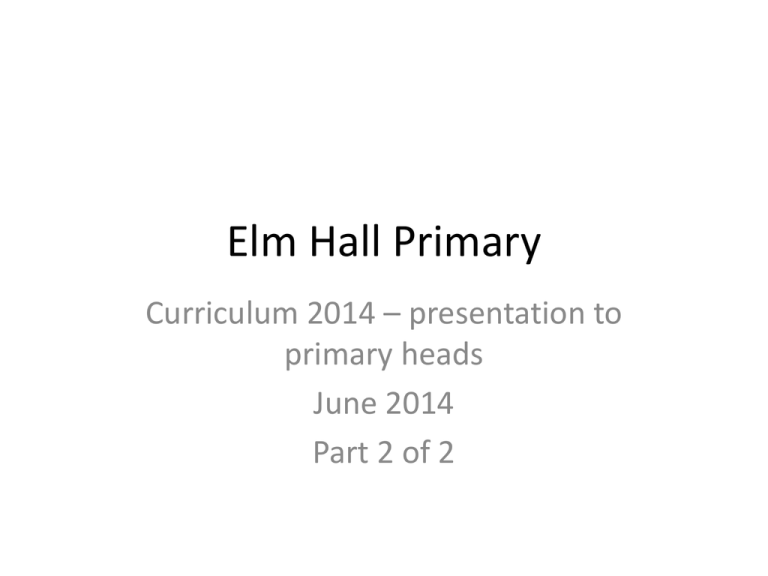
Elm Hall Primary Curriculum 2014 – presentation to primary heads June 2014 Part 2 of 2 Progress Based Numeracy Planning using Blooms Taxonomy Teacher: Class: Week Beginning : Date Lesson Focus Mental Starter Objective Learning Challenge Can I… Mental Starter Group Learning Challenge Support TA . Skill to be learnt Learning to be consolidated Success Criteria Task Extension Questions Plenary Knowledge and understand Consolidate Understand and Apply Consolidate Apply And Analyse Consolidate Apply and Evaluate Consolidate Apply, Evaluate and create Challenge Auditing Maths across the curriculum linking maths with the rest of the curriculum Principle Possible activities ACTIVILTY PRINCIPLE Active learning Learning by doing where children develop their own mathematical tools and choose resources for solving problems. investigations Predictions Guesstimates Analysing visual stimuli Drawing creating developing ideas physical representation making models building play based learning outdoor maths forest school activities making own resources being the expert evaluating understanding linking learning maths talk REALITY Use mathematical tools to solve problems and learn mathematics to be useful for their future. Related to experiences, while working on PRINCIPLE contextual problems, children develop mathematical tools and understanding Linking maths to real life situations What’s in the news? investigations Data handling TASC [Belle Wallace] Maths through stories language science links architecture links with local community Going to the shops 2D/3D Art create a challenge environment Global dimensions skills in context ICT Real life scenarios Finance DIFFERENTIATION PRINCIPLE Choose your challenge COMMUNICATION PRINCIPLE USE AND APPLY PRINCIPLE Reflect, review and evaluate - skills ; learning; success criteria met; arriving at the next level Independent enquiry active learning Thinking creatively Consolidation steps to success Scaffolding thinking self differentiation maths talk self assessment self challenge Graffiti maths child led plenaries Opportunities to share strategies and inventions with each other as interaction promotes reflection that increases their level of understanding Co-operative learning check/assess own work pair share/square share child initiated plenaries maths talk MoE teach someone else sharing strategies peer assessment group work Supporting learning attitude Graffiti maths Creating deeper levels of understanding of mathematical principles involved in a broad range of situations: solve rich contextual problems as life skills. Linking prior learning to new concepts child led plenaries. assessment FACILITATE LEARNING PRINCIPLE link prior knowledge create a challenge scaffolding learning investigation TASC links to all aspects of the curriculum and wider context building learning power maths talk choose your challenge self Process of working with others achieving self-growth /self-evaluation / cooperation /explore, learn and change/take control of their learning Child centred activities range of resources ICT opportunities Clear success criteria scaffold the learning RUCSAC learning environment motivational challenge Engaging activities Use of Blooms Taxonomy Assessment for Learning child lead activities guided groups TASC building learning power Supporting learning attitude child led/initiated activities Mantle of the expert next step targets Real life scenarios create a challenge investigations Talk For Maths making maths relevant We want the children to: • See the use of maths in their environment. • Embed mathematical language into their daily vocabulary. • Form systematic links between mathematical concepts. • Develop problem solving skills by using and applying their maths knowledge and strategies. Meaningful Maths • The following Principles are underpinned by the national curriculum, mental arithmetic, paper and pencil procedures and calculation skills. • All principles are inter-related and are not taught as separate principles • RUCSAC read; underline key words; choose operation; solve problem; answer question; check answer • • • • • Activity principle: Learning by doing. Children develop their own mathematical tools and choose resources for solving problems • • • • • • • • • • • • Reality principle: Children are able to use mathematical tools to solve problems and learn mathematics to be useful for their future. Related to experiences, while working on contextual problems, children develop mathematical tools and understanding. Differentiation principle The circumstance for arriving at the next level is the ability to reflect on activities accomplished and which guides growth as children pass through various levels of understanding. Communication principle We offer pupils the opportunities to share their strategies and inventions with each other as interaction promotes reflection that increases their level of understanding. Use and apply principle Creating deeper levels of understanding of mathematical principles involved in a broad range of situations. Children need to be able to solve rich contextual problems as life skills. Facilitate learning principle Facilitation of learning refers to the process of helping learners achieve self-growth through self-evaluation and cooperation with others. It is about helping people to explore, learn and change. Facilitated learning occurs when the students are encouraged to take more control of their learning process. Maths language The Number System • • • • • • • • • • • • • • • • • • • Greater than Less than Equal to Ascending Descending Order Approximately Positive Negative Exactly Odd Even Consecutive Square number Multiple of Pair Rule Relationship Formula Fractions, Percentage, Ratio and Proportion Numerator Denominator In every For every Percentage Whole Half Quarter Proportion Equal parts As many as Factor Decimal Per cent % Calculation Add Sum Total Plus Increase Double Near double Subtract Minus Difference between Inverse Altogether Is the same as Lots of Groups of Once Twice Double Halve Share equally Factor Remainder Multiple Divisible by Divide Row Column Array Remainder Factor Measures, Shape and Space Measurement Measure Size Compared to Length Width Height Depth Longest Shortest Edge Perimeter Distance between Furthest Vertex Vertices Radius Diameter Circumference Face Regular Irregular Congruent Intersect Positional and Directional Position Over Under Above Below Top Bottom In front Behind Front After Beside Opposite Parallel Perpendicular Rotate Acute Obtuse Right angle Straight line Horizontal Vertical Ascend Descend Bisect Handling Data and Probability Tally Survey Represent Line graph Bar chart Frequency Mode Range Mean Maximum value Minimum value Most popular Least likely Most common Least common Label Title Axis Classify Fair Unfair Certain Uncertain Probable Impossible Possible Pattern and Symmetry Size Symmetrical Line of symmetry Axis of symmetry Mirror line Reflection Translated Repeating pattern Fold Reflective symmetry Rotated Identical Bigger Smaller Larger Money Money Coin Note Penny Pence Pound Price Cost Buy Sell Discount Profit Loss Total Amount Value Spend Spent Change Most expensive Least expensive Pay Capacity Full Halve full Empty Contains Holds Litre Millimetre Container Measuring cylinder Volume Area Area Covers Surface Square centimetre Square metre Square millimetre Surface Area Time Days Monday Tuesday Wednesday Thursday Friday Saturday Sunday Week Month Year Decade Century Yesterday Today Tomorrow Hour min Shape Names Regular: Triangle Square Pentagon Hexagon Heptagon Octagon Nonagon Decagon Quadrilaterals: Square Rectangle Rhombus Parallelogram Trapezium Kite Trapezoid 3D shapes: Cube Cuboid Sphere Cylinder Cone Triangular Prism Hexagonal Prism Triangular based pyramid Square Based Pyramid Hexagonal Based Pyramid 1 1 2 Learning Grids 3 4 5 6 Choose your challenge Differentiated activities 2 3 4 5 6 Shape Challenges 1 2 3 4 5 6 1 Draw an arrowhead with a line of symmetry through the middle. Draw a kite with a line of symmetry. Draw an isosceles trapezium. Draw a scalene triangle. Draw a equilateral triangle. Draw a compound shape containing a rectangle and a equilateral triangle 2 Draw a parallelogram. Draw a irregular hexagon. Draw a concave polygon. Draw a convex polygon. Draw a compound shape containing 2 rectangles. Draw a trapezium. 3 Draw an isosceles triangle. Draw a irregular octagon. Draw a parallelogram. Draw a parallelogram. Draw a regular hexagon. Draw a Rhombus. 4 Draw a irregular pentagon. Draw a concave polygon. Draw a compound shape containing a square and a right angle triangle. Draw a kite with a line of symmetry. Draw a convex polygon. Draw an isosceles triangle. 5 Draw an isosceles trapezium. Draw a irregular octagon. Draw a compound shape containing 3 different types of triangle. Draw a convex polygon. Draw a regular pentagon. Draw a compound shape containing 3 different types of triangle. 6 Draw a convex polygon. Draw a parallelogram. Draw a compound shape containing 2 rectangles. Draw a convex polygon. Draw a parallelogram. Draw a Rhombus. Algebra – Work out X 1 2 3 4 5 6 1 x+5= 32 25–x = 12 2x+6= 24 3x + 2x=25 2x + 10 =2 4x ÷2=8 2 10x + 5 = 105 34 + 2x = 56 12 – 2x = 8 32 – 4x = 24 3x + 10 = 43 7x – 6 = 36 3 4x + 2x = 60 3x + 7x = 100 3x – x = 24 12 + 2x + 3x = 62 9x = 81 4x + 3x = 77 4 5x + 15x = 60 2x ÷ 4 = 20 3x – 2x = 5 2x + 5 = 3x 7x + x = 64 6x + 30 = 90 5 4x = 64 5x + 5x = 100 2x = 35 - 15 4x + 3x + 5 = 75 3x + x = 44 21 + 2x = 35 6 5x – 12 = 13 66 – 2x = 44 2x + 15 = 105 2(x + 2) = 34 13 + 2x = 25 8x + 4x = 144 Create your own 1 1 2 3 4 5 6 2 3 4 5 6 TASC Teaching in a social context [Belle Wallace] Year 5/6 Context War torn Afghanistan needs supplies dropped behind enemy lines; Learning Challenge Design a parachute and container to drop the cargo from a plane. Coverage Science; Design Technology; Global dimensions; geography; History; Life skill [PLT’s] TASC Teaching in a social context [Belle Wallace] Year 5/6 Context War torn Afghanistan needs supplies dropped behind enemy Learning Challenge Design a parachute and container to drop the cargo from a p Coverage Science; Design Technology; Global dimensions; Geography; History; Life skill [PLT’s] Mike Gershon Free power point down loads ‘Post It Note Pedagogy’ Post It Note Formative Feedback ‘The Ideas Tree’ Key Subject Specific Vocabulary Secret Teacher Feedback The Post It Plenary Question Wall magpie Assess peer group work



